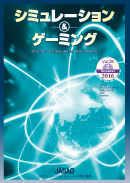Volume 26, Issue 2
Displaying 1-9 of 9 articles from this issue
- |<
- <
- 1
- >
- >|
Special Issue: Simulation & Gaming in Health and Medical Service
-
2017Volume 26Issue 2 Pages 41
Published: December 25, 2017
Released on J-STAGE: September 12, 2019
Download PDF (149K)
Peer-Reviewed Paper
-
2017Volume 26Issue 2 Pages 42-51
Published: December 25, 2017
Released on J-STAGE: September 12, 2019
Download PDF (618K) -
2017Volume 26Issue 2 Pages 52-63
Published: December 25, 2017
Released on J-STAGE: September 12, 2019
Download PDF (1132K) -
2017Volume 26Issue 2 Pages 64-68
Published: December 25, 2017
Released on J-STAGE: September 12, 2019
Download PDF (578K)
Forum
-
2017Volume 26Issue 2 Pages 69
Published: December 25, 2017
Released on J-STAGE: September 12, 2019
Download PDF (116K) -
2017Volume 26Issue 2 Pages 70
Published: December 25, 2017
Released on J-STAGE: September 12, 2019
Download PDF (190K)
Reports
-
2017Volume 26Issue 2 Pages 71-73
Published: December 25, 2017
Released on J-STAGE: September 12, 2019
Download PDF (325K) -
2017Volume 26Issue 2 Pages 74-75
Published: December 25, 2017
Released on J-STAGE: September 12, 2019
Download PDF (194K)
Editor’s Note
-
2017Volume 26Issue 2 Pages 76
Published: December 25, 2017
Released on J-STAGE: September 12, 2019
Download PDF (147K)
- |<
- <
- 1
- >
- >|
